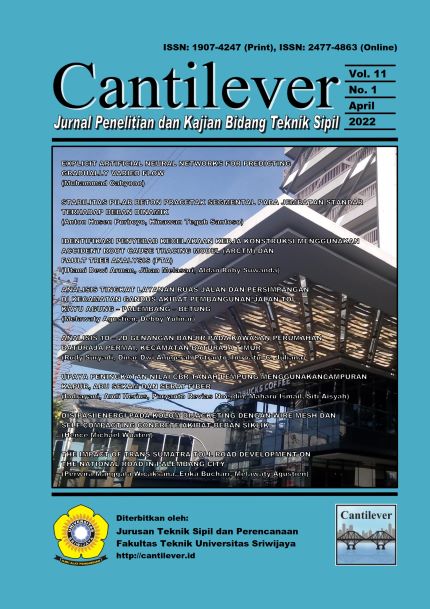Analisis Tingkat Layanan Ruas Jalan dan Persimpangan di Kecamatan Gandus Akibat Pembangunan Jalan Tol Kayu Agung – Palembang - Betung Analysis of Service Levels for Roads and Intersections in Gandus District Due to Construction of Kayu Agung – Palembang - Betung Toll Road
Main Article Content
Abstract
The construction of Musi V Bridge is part of the series of Kapal Betung Toll Road, with the toll road in and out of Social Street which is connected to Lettu Karim Kadir Street. This study aims to obtain the performance of roads and intersections in Gandus District, obtain transportation modeling of traffic movements due to KayuAgung-Palembang-Betung Toll Road interchange, obtain predictions of the performance of roads and intersections resulting from traffic simulation models and provide policy suggestions in the form of strategies and traffic engineering management techniques. Data processing used the 2014 PKJI method and simulation with Vissim program. Results of data processing show that the performance of roads and intersections in existing conditions is still able to accommodate traffic flow, indicated by the degree of saturation that meets 2014 PKJI requirements, namely (DJ ≤ 0.85) with service level C and Vissim simulation results show the largest delay and queue length located in segment 3 (M Amin Fauzi Street -Tph Sofyian Kenawas Street) which is 138.18 meters and 21.02 seconds and on Lettu Karim Kadir Street (Direction of Musi II) of 14.04 seconds and 58.96 meters. After the operation of the Musi V Bridge, there was an increase in traffic volume which resulted in decreased performance of roads and intersections. Therefore, to improve its performance, road widening is carried out. The results of 2014 PKJI analysis showed a decrease in the degree of saturation from 0.43 to 0.35, a delay from 9.02 seconds / cur to 8.22 seconds / cur and the chances of queuing from 8.50 - 20.39% to 6.04 - 15.91% on Lettu Karim Kadir Street (Musi II Direction).
Downloads
Article Details
BPS-Statistic of Palembang Municipality, (2021). Palembang Municipality in Figures.
Departemen Pekerjaan Umum. (2014). Pedoman Kapasitas Jalan Indonesia (PKJI). Direktorat Jenderal Bina Marga. Jakarta.
Khisty, C.J., Dasar-Dasar Rekayasa Transportasi, (2005) Edisi Ketiga, Erlangga.
Koloway, (2009). Kinerja Ruas Jalan Perkotaan Jl. Prof.Dr.satrio, Jurnal Perencanaan Wilayah dan Kota, Indonesia, vol. 20, no. 3, pp. 215-230
Intari, D.Esti, (2019). Analisis Kinerja Simpang Tiga Tak Bersinyal (Studi Kasus : Simpang Tiga Jalan Raya Serang Km 24 – Jalan Akses Tol Balaraja Barat, Balaraja, Kabupaten Tangerang, Banten).
R. Setiawan., (2018). Simulasi Manajemen Lalu Lintas Untuk Mengurangi Kemacetan Di Jalan Jemursari Dan Raya Kendangsari,” Jurnal Teknik Sipil, Vol-3 No.1 Universitas Kristen Petra, Surabaya.
T. S. A. Tarigan dan M. S. Surbakti, (2016). Simulasi Koordinasi Rambu Lalu Lntas Terhadap Volume Kendaraan Saat Waktu Puncak Lalu Lintas Di Persimpangan Menggunakan Software Vissim, Engineering Journal of Civil Engineering, Vol.2 No.2 Universitas Sumatera Utara, Medan.
Waris, Milawaty, (2018). Analisis Kinerja Simpang Tak Bersinyal Metode Pedoman Kapasitas Jalan Indonesia 2014”. Sulawesi Barat.

This work is licensed under a Creative Commons Attribution-NonCommercial 4.0 International License.
Authors who publish with this journal agree to the following terms:
- Authors retain copyright and grant the journal right of first publication with the work simultaneously licensed under a Creative Commons Attribution-NonCommercial 4.0 International License that allows others to share the work with an acknowledgment of the work's authorship and initial publication in this journal.
- Authors are able to enter into separate, additional contractual arrangements for the non-exclusive distribution of the journal's published version of the work (e.g., post it to an institutional repository or publish it in a book), with an acknowledgment of its initial publication in this journal.
- Authors are permitted and encouraged to post their work online (e.g., in institutional repositories or on their website) prior to and during the submission process, as it can lead to productive exchanges, as well as earlier and greater citation of published work (See The Effect of Open Access).
